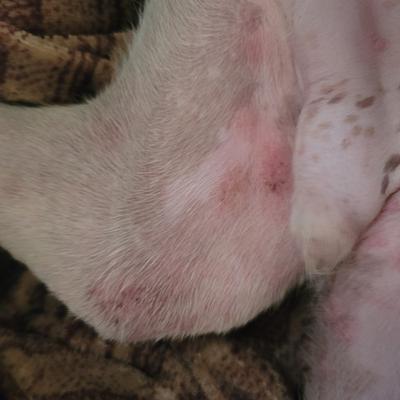What are These Red Spots on my Dog's Leg
by Debbie
(Saint johns Arizona )
My dog keeps on itching and licking and biting his back leg I want to know what he has .....I am having trouble identifying what it could be ....
Editor Suggestions for Causes of a Rash on One Dog Leg
Hi Debbie,
Sorry to hear about your dog's leg rash.
The image shows a light red rash on the dog's back leg. The affected area appears to be slightly inflamed, but there are no obvious signs of severe infection, bleeding, or open sores.
Here is a list of likely causes in order of likeliness and treatment options for each:
1. Hot Spots: Hot spots are localized areas of skin infection and inflammation. A "hot spot," or acute moist dermatitis, is a localized area of skin inflammation and bacterial infection that often occurs from a cycle of itching, scratching, and licking. The hot spot itself can be caused by most of the items on this list including allergic reaction, flea to rick bites, injury such as a scrape, joint pain (licking or chewing the area could lead to a hot spot), a foreign object that gets embedded in the skin leading to irritation or a skin infection.
Course of Action: Keep the area clean and dry. Consult your veterinarian for antiseptic solutions and potential antibiotic or steroid treatment.
2. Flea Infestation: Fleas can target specific areas, and some dogs have a hypersensitivity to flea bites that could cause a localized reaction.
Course of Action: Check for fleas and treat with a veterinarian-approved flea medication.
3. Bacterial Infection: A secondary bacterial infection could arise from constant licking and scratching of a specific area.
Course of Action: Consult a veterinarian for a skin scrape test and possible antibiotic treatment.
4. Trauma or Injury: If the dog has injured that specific leg, it could be causing discomfort leading to the symptoms.
Course of Action: Examine the leg for signs of injury and consult your veterinarian for appropriate treatment.
5. Allergies: The fact that the rash is localized to one leg does make allergies less likely as the primary cause, although not impossible. Allergic reactions often manifest as more generalized symptoms affecting multiple areas of the body. However, it is possible for
6. Parasitic Infections: Less common but still possible, mites or lice could focus on a specific area.
Course of Action: A vet can diagnose this through a skin scraping test and may prescribe antiparasitic medication.
As you can see from the long list you will need a veterinarian to help identify the exact cause and treatment approach.
To diagnose the cause of a hot spot or similar skin condition on your dog's leg, a veterinarian will generally follow these initial steps:
Clinical History and Physical Examination: The veterinarian will start by asking you about your dog's medical history, including any previous skin issues, allergies, and the onset of current symptoms. A thorough physical examination of the affected area and other parts of the body will also be conducted.
Visual Inspection: The vet will closely examine the hot spot, noting its size, shape, and degree of inflammation or infection.
Palpation: The vet may gently touch the area to assess the degree of pain, warmth, or swelling, which can give clues about the severity and potential cause.
Skin Scraping Test: If parasites are suspected, a skin scraping test may be performed. This involves scraping a small amount of skin with a blade and examining it under a microscope for the presence of parasites like mites.
Cytology: Swabbing the area and examining the sample under a microscope can help identify bacterial or fungal infections.
Allergy Testing: If allergies are suspected, a veterinarian may recommend an intradermal skin test or a blood test for allergens.
X-rays or Ultrasound: If an underlying issue like arthritis or a foreign object is suspected, imaging studies may be recommended.
The veterinarian may not perform all these tests for every case; the specific approach will depend on the initial findings and the suspected underlying cause. Once the diagnosis is made, a tailored treatment plan will be recommended.
Please keep us up to date on yoru dog's condition.
Jeff
Editor and Publisher
Dog Health Guide
Please note: This information is intended to complement, not replace, the advice of your pet's veterinarian. Always consult a vet for professional medical advice about your pet's health.
Join in and write your own page! It's easy to do. How? Simply click here to return to Skin.


